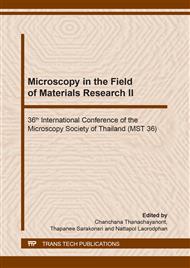p.63
p.71
p.79
p.85
p.93
p.101
p.107
p.115
p.123
Feasibility Study of Using Modified Recycled Fiber-Cement for the Production of High Performance Fiber-Cement Composites
Abstract:
The aim of this work is to study the feasibility of recycling the rejected fiber-cement composites as the filler in the fiber-cement mixture for producing the new fiber-cement composites. The rejected fiber-cement composites were ground and mixed with ordinary Portland cement (OPC), sand, cellulose fiber, and the dissolving agent which was a chemical prepared from the proprietary blend of citric acid together with thickening and wetting agent. The samples (75 mm × 200 mm × 7 mm) were prepared by mixing the raw materials, including 34.25 wt% OPC, 30 wt% sand, 5.5 wt% cellulose fiber, and 30.25 wt% recycled fiber-cement composites. Then, the dissolving agent was added in the amount of 0 to 4.5 % of the OPC weight in the mixture. The mixtures of raw materials were mixed with water to form the slurry. Then, the green samples were produced by the filter pressing method. After molding, the green samples were autoclaved at pressure 10 bars and temperature 180 °C for 16 hrs. After that, the microstructure of the autoclaved samples was examined by scanning electron microscope (SEM). The modulus of rupture (MOR) and modulus of elasticity (MOE) of the samples were measured by universal testing machine (UTM) based on ASTM C1186-08 standard. The results showed that properties of the samples passed the requirements of the industrial standard. In addition, the utilization of dissolving agent affects both the microstructure and the properties of the samples.
Info:
Periodical:
Pages:
93-99
Citation:
Online since:
April 2020
Price:
Сopyright:
© 2020 Trans Tech Publications Ltd. All Rights Reserved
Share:
Citation:


